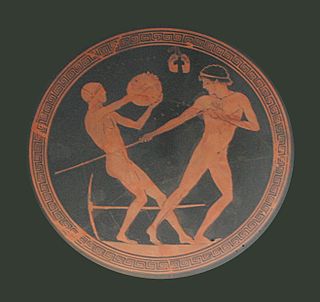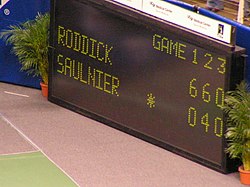
The biathlon is a winter sport that combines cross-country skiing and rifle shooting. It is treated as a race, with contestants skiing through a cross-country trail whose distance is divided into shooting rounds. The shooting rounds are not timed per se, but depending on the competition, missed shots result in extra distance or time being added to the contestant's total.

Orienteering is a group of sports that involve using a map and compass to navigate from point to point in diverse and usually unfamiliar terrain whilst moving at speed. Participants are given a topographical map, usually a specially prepared orienteering map, which they use to find control points. Originally a training exercise in land navigation for military officers, orienteering has developed many variations. Among these, the oldest and the most popular is foot orienteering. For the purposes of this article, foot orienteering serves as a point of departure for discussion of all other variations, but almost any sport that involves racing against a clock and requires navigation with a map is a type of orienteering.

Nordic combined is a winter sport in which athletes compete in cross-country skiing and ski jumping. The Nordic combined at the Winter Olympics has been held since the first Winter Olympics in 1924, while the FIS Nordic Combined World Cup has been held since 1983. Many Nordic combined competitions use the Gundersen method, where placement in the ski jumping segment results in time (dis)advantages added to the contestant's total in the cross-country skiing segment.

Ski jumping is a winter sport in which competitors aim to achieve the farthest jump after sliding down on their skis from a specially designed curved ramp. Along with jump length, competitor's aerial style and other factors also affect the final score. Ski jumping was first contested in Norway in the late 19th century, and later spread through Europe and North America in the early 20th century. Along with cross-country skiing, it constitutes the traditional group of Nordic skiing disciplines.

The modern pentathlon is an Olympic sport consisting of fencing, freestyle swimming, equestrian show jumping, pistol shooting, and cross country running. The event was first held in 1912, inspired by the traditional pentathlon held during the ancient Olympics, and designed to model skills needed by a soldier of that time. As well as being an Olympic event, a world championships has been held annually since 1949.

The FIS Alpine Ski World Cup is the top international circuit of alpine skiing competitions, launched in 1966 by a group of ski racing friends and experts which included French journalist Serge Lang and the alpine ski team directors from France and the USA. It was soon backed by International Ski Federation president Marc Hodler during the FIS Alpine World Ski Championships 1966 at Portillo, Chile, and became an official FIS event in the spring of 1967 after the FIS Congress at Beirut, Lebanon.

Track and field is a sport that includes athletic contests based on running, jumping, and throwing skills. The name is derived from where the sport takes place, a running track and a grass field for the throwing and some of the jumping events. Track and field is categorized under the umbrella sport of athletics, which also includes road running, cross country running and racewalking. In British English the term "Athletics" is synonymous with American "Track and Field" and includes all jumping events.

A pentathlon is a contest featuring five events. The name is derived from Greek: combining the words pente (five) and -athlon (competition). The first pentathlon was documented in Ancient Greece and was part of the Ancient Olympic Games. Five events were contested over one day for the Ancient Olympic pentathlon, starting with the long jump, javelin throwing, and discus throwing, followed by the stadion and wrestling. Pentathletes were considered to be among the most skilled athletes, and their training was often part of military service—each of the five events in the pentathlon was thought to be useful in war or battle.
A quadrathlon is an endurance sports event composed of four individual disciplines. All four disciplines are completed in succession and the lowest overall time decides the winner.
Pursuit racing is where two or more competitors are either chasing after each other or chasing after a lead competitor or team.

Australia first competed in the Winter Olympic Games in 1936 in Garmisch-Partenkirchen, and has participated in every games since, with the exception of the 1948 Games in St. Moritz.

France competed at the 1912 Summer Olympics in Stockholm, Sweden. 119 competitors, 118 men and 1 woman, took part in 66 events in 13 sports.

Russian Empire (Russia) competed at the 1912 Summer Olympics in Stockholm, Sweden. 159 competitors took part in 62 events in 15 sports.

Norway competed at the 1912 Summer Olympics in Stockholm, Sweden. 190 competitors, 188 men and 2 women, took part in 58 events in 14 sports.

Germany competed at the 1912 Summer Olympics in Stockholm, Sweden. 185 competitors, 180 men and 5 women, took part in 69 events in 14 sports. Due to the political fallout from World War I, this was the country's last appearance until 1928.

Great Britain competed at the 2008 Summer Paralympics in Beijing, People's Republic of China. Great Britain sent a delegation of around 400, of which 212 were athletes, to compete in eighteen sports at the Games. The team was made up of athletes from the whole United Kingdom; athletes from Northern Ireland, who may elect to hold Irish citizenship under the pre-1999 article 2 of the Irish constitution, are able to be selected to represent either Great Britain or Ireland at the Paralympics. Additionally some British overseas territories compete separately from Britain in Paralympic competition.

The Union Internationale de Pentathlon Moderne, commonly known by the acronym UIPM, has been the international governing body of modern pentathlon since its foundation in London in 1948. Its headquarters are in Monte-Carlo, Monaco, and it has 115 national federation members. Modern pentathlon was introduced at the fifth Olympiad in Stockholm, Sweden, in 1912, comprising the contemporary sports of pistol shooting, fencing, swimming, horse riding and running, which embraced the spirit of its ancient counterpart.

The first European Athletics Team Championships took place on 20 and 21 June 2009. The track and field athletics tournament run by European Athletics was the successor of the old European Cup competition which was held annually until 2008. The Championships saw a number of new rules introduced, which were criticised by some athletes and observers.
The Kellogg's Nutri-Grain Ironman and Ironwoman Series is a professional iron man and iron women racing series, born out of surf livesaving.
















